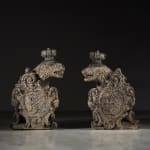Heraldic Lions
A Pair of Carved Limestone Heraldic Lions
Central European, Habsburg Territories, late 17th century
Height: 90cm Width: 57cm Depth: 77cm
A striking pair of limestone lions, carved in full relief and designed as true opposites. Each is seated upright, with bared teeth, strong haunches and a tightly curled mane. Both wear a crown and hold an oval cartouche carved in bold relief with an interlaced monogram. They were made to flank the formal entrance of a major estate.
The form and detailing are typical of high-status Baroque culture in Central Europe and the crown design is especially telling. Each features a repeating pattern of fleur-de-lis and crosses, closely following the design of imperial crowns used in Habsburg heraldry - particularly in the realms of Austria and Bohemia.
A crucial distinction is the placement of such a crown directly on the animal - not merely above the cipher - which indicates an emblem of royal standing.
Comparable examples can be seen on the monumental lions at Prince Eugene of Savoy's Upper Belvedere Palace in Vienna and others across Bavaria and Austria, where lions were used as heraldic supporters for noble or imperial arms. The monograms are hard to decipher but are almost certainly ciphers for the original owners or patrons.
They likely stood at the gates of a major estate or seat of power under Habsburg rule or allegiance, marking out territories and status.
Central European, Habsburg Territories, late 17th century
Height: 90cm Width: 57cm Depth: 77cm
A striking pair of limestone lions, carved in full relief and designed as true opposites. Each is seated upright, with bared teeth, strong haunches and a tightly curled mane. Both wear a crown and hold an oval cartouche carved in bold relief with an interlaced monogram. They were made to flank the formal entrance of a major estate.
The form and detailing are typical of high-status Baroque culture in Central Europe and the crown design is especially telling. Each features a repeating pattern of fleur-de-lis and crosses, closely following the design of imperial crowns used in Habsburg heraldry - particularly in the realms of Austria and Bohemia.
A crucial distinction is the placement of such a crown directly on the animal - not merely above the cipher - which indicates an emblem of royal standing.
Comparable examples can be seen on the monumental lions at Prince Eugene of Savoy's Upper Belvedere Palace in Vienna and others across Bavaria and Austria, where lions were used as heraldic supporters for noble or imperial arms. The monograms are hard to decipher but are almost certainly ciphers for the original owners or patrons.
They likely stood at the gates of a major estate or seat of power under Habsburg rule or allegiance, marking out territories and status.
Further images
-
(View a larger image of thumbnail 1
)

-
(View a larger image of thumbnail 2
)

-
(View a larger image of thumbnail 3
)

-
(View a larger image of thumbnail 4
)

-
(View a larger image of thumbnail 5
)

-
(View a larger image of thumbnail 6
)

-
(View a larger image of thumbnail 7
)

-
(View a larger image of thumbnail 8
)

-
(View a larger image of thumbnail 9
)

-
(View a larger image of thumbnail 10
)










